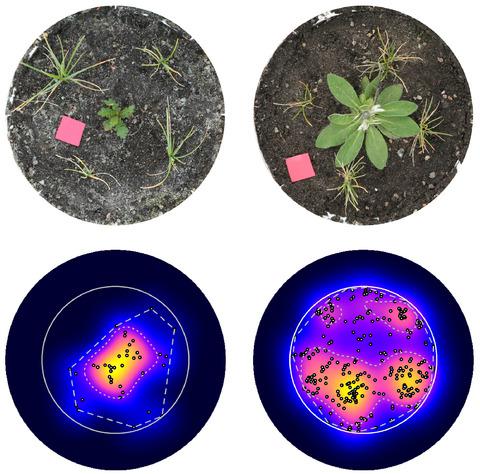Our official English website, www.x-mol.net, welcomes your
feedback! (Note: you will need to create a separate account there.)
Spatial mapping of root systems reveals diverse strategies of soil exploration and resource contest in grassland plants
Journal of Ecology ( IF 5.3 ) Pub Date : 2020-10-27 , DOI: 10.1111/1365-2745.13535 Anu Lepik 1 , Maria Abakumova 1 , John Davison 1 , Kristjan Zobel 1 , Marina Semchenko 1, 2
中文翻译:

根系的空间作图揭示了草原植物土壤探索和资源竞争的各种策略
更新日期:2020-10-27
Journal of Ecology ( IF 5.3 ) Pub Date : 2020-10-27 , DOI: 10.1111/1365-2745.13535 Anu Lepik 1 , Maria Abakumova 1 , John Davison 1 , Kristjan Zobel 1 , Marina Semchenko 1, 2
Affiliation

|
- When foraging and competing for below‐ground resources, plants have to coordinate the behaviour of thousands of root tips in a manner similar to that of eusocial animal colonies. While well described in animals, we know little about the spatial behaviour of plants, particularly at the level of individual roots.
- Here, we employed statistical methods previously used to describe animal ranging behaviour to examine root system overlap and the efficiency of root positioning in eight grassland species grown in monocultures and mixtures along a gradient of neighbour densities.
- Species varied widely in their ability to distribute roots efficiently, with the majority of species showing significant root aggregation at very fine spatial scales. Extensive root system overlap was observed in species mixtures, indicating a lack of territoriality at the level of whole root systems. However, with increasing density of competitors, several species withdrew roots from the periphery of foraging ranges and increased intraplant root aggregation in the remaining area, which may indicate consolidation of foraging areas under competitive pressure.
- Several species exhibited responses consistent with resource contest in species mixtures where encounters with competitors’ roots triggered increased root aggregation at the expense of foraging efficiency. Such responses only occurred in mixtures of species with comparable competitive abilities but were absent in asymmetric species combinations.
- Synthesis. Combining fine‐scale measurement of plant root distributions with spatial statistics yields new insights into plant behavioural strategies with significant potential to impact resource foraging efficiency and productivity.
中文翻译:

根系的空间作图揭示了草原植物土壤探索和资源竞争的各种策略
- 在觅食和争夺地下资源时,植物必须以与正常社会动物群落类似的方式协调成千上万根根尖的行为。尽管在动物中得到了很好的描述,但我们对植物的空间行为知之甚少,特别是在单个根的水平上。
- 在这里,我们采用了以前用来描述动物测距行为的统计方法,以检查根系重叠以及沿单一种植体和混合物沿邻域密度梯度生长的八种草地物种的根系定位效率。
- 物种有效分布根的能力差异很大,大多数物种在非常精细的空间尺度上显示出显着的根聚集。在物种混合物中观察到广泛的根系重叠,表明在整个根系水平上缺乏地域性。然而,随着竞争者密度的增加,一些物种从觅食范围的外围撤回了根,并增加了其余区域内的植物内根的聚集,这可能表明在竞争压力下觅食区域的整合。
- 几个物种在物种混合物中表现出与资源竞争一致的反应,其中竞争者根系的接触触发了根系聚集的增加,但以觅食效率为代价。这种反应仅发生在具有相当竞争能力的物种混合物中,而在非对称物种组合中则不存在。
- 综合。将植物根系分布的精细测量与空间统计相结合,可获得对植物行为策略的新见解,而这些行为策略对影响资源觅食的效率和生产力具有巨大的潜力。











































 京公网安备 11010802027423号
京公网安备 11010802027423号